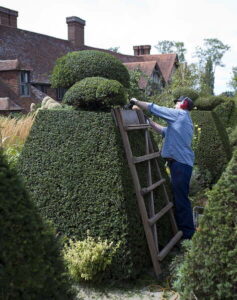There’s something satisfying about trimming a hedge – until you step back and realise that it’s all just a bit wonky
Hedge-trimming and shaping is an horticultural art form. While we’d all like to embrace our inner Edward Scissorhands, learning how to trim or shape a hedge correctly takes years of practice, an eye for detail and more than an ounce of patience.
What do you need to know about trimming a hedge?
Before you sharpen the shears and let loose, there’s three key things you should know, prior to starting the annual trim and shape.
When to have a hedge trimming service done?
Most hedge trimming services are done just as you’re coming out of the Melbourne winter and before the start of the spring growth. As most plants lie relatively dormant throughout the colder months, reducing their foliage at this time causes the least amount of stress.
If your hedge is deciduous (it drops all of its leaves in winter), shape while the branches are bare and before the start of new leaf buds or flowers.
If your hedge is evergreen, you can shape at any time, however, you must be aware of how much foliage you remove: In summer, no more than 10%, winter you can remove up to 30%.
How to trim or shape your hedge?
Young trees respond better to regular trimming or shaping. Not only does it encourage new growth, but it also removes any branches that may develop deadwood through the tree’s natural detoxification process.
When shaping your hedge, always try to keep the top slightly tapered as this allows the bottom of the hedge to receive sunlight for balanced photosynthesis.
If you’re after a straight edge, set string lines as a guide so you have something to follow.
What can go wrong when you trim or shape your hedge?
hedge trimming at the wrong time of the year will stress the plant, leading to stunted growth or make it more susceptible to infection and disease. All deciduous plants should be trimmed when they have bare branches.
Not all species of hedging plants like to have a hard or hefty cutback. On certain species, e.g. conifers, cutting back the hardwood will often cause such damage to the plant that it’s not unusual for them to die. Until you know your garden well, or if you’re working with established trees, it’s better to do several smaller trims overall, than one massive shape at the beginning of the season.
Don’t trust your eye to keep your straight edges in line. Even the most experienced horticulturalists use a string line. Quick growing hedging plants can be more forgiving if their trim ends up lopsided, but slow growers like English Box will have you looking at your mis-cuts for many years to come.
And lastly, make sure you clean and sharpen your hedge trimming tools or shears before you start the job. You want to make sure you have clean cuts to prevent infections and clean blades to prevent the spread of disease.
If you’re unsure of the species of plant used in your hedge, take a photo and send it to us and we’ll help you identify it.
Importance of Hedge Trimming
Hedge trimming is an essential task for maintaining a well-kept and attractive outdoor space. Regular trimming promotes healthy growth, preventing hedges from becoming overgrown and unsightly. It also allows you to shape hedges to your desired look and keeps them in top condition. Proper hedge trimming not only improves the appearance of your garden, but it also helps to ensure the longevity of your hedges.
Choosing the Right Hedge Trimmer
When it comes to hedge trimming, having the right tools is crucial. There are several types of hedge trimmers available, including manual and powered options. It is important to choose a hedge trimmer that is suitable for the size and type of hedge you have, as well as for your own level of experience and physical ability. Consider factors such as the length of the blade, the weight of the tool, and the ease of use when making your decision.
Preparing for Hedge Trimming
Before starting to trim your hedges, it is important to prepare properly. This includes gathering the necessary tools and equipment, such as protective gloves and eye wear, as well as cleaning and maintaining your hedge trimmer. It is also important to plan out the trimming process, including which areas to trim first and how to trim effectively without damaging the hedge.
Tips for Effective Hedge Trimming
For effective hedge trimming, it is important to use the right techniques. Start by trimming the sides of the hedge, working from the top down. Make sure to trim evenly, paying attention to the overall shape of the hedge. Avoid over-trimming, which can damage the hedge and slow down its growth. Instead, aim for a natural, rounded shape.
Maintaining Your Hedge Trimmer
Proper maintenance of your hedge trimmer is essential for ensuring its longevity and performance. Clean the blades after each use and store the trimmer in a dry place. Regularly lubricate the moving parts, and have the trimmer serviced by a professional if necessary. Taking good care of your hedge trimmer will help to extend its lifespan and ensure that it continues to perform effectively for years to come.
Frequently Asked Questions about Hedge Trimming
How often should I trim my hedges?
It is recommended to trim your hedges at least once a year, and twice a year is even better. This will help ensure that the hedge remains in top condition and continues to enhance the look of the outdoor space.
What is the best time of year to trim hedges?
The best time to trim hedges varies depending on the type of hedge. For deciduous hedges, it is recommended to trim them after they have finished flowering or in late summer. For evergreen hedges, it is best to trim them in spring or early summer.
Can I trim my hedges in the winter?
Trimming hedges in the winter is generally not recommended as it can damage the hedge. However, evergreen hedges can be trimmed in the winter if necessary, but avoid trimming deciduous hedges during this time.
What is the best way to shape my hedges?
The best way to shape hedges is to aim for a natural, rounded shape. Start by trimming the sides of the hedge, working from the top down, and make sure to trim evenly. Avoid over-trimming, which can damage the hedge and slow down its growth.
How can I prevent damage to my hedges during trimming?
To prevent damage to your hedges during trimming, make sure to use sharp, clean blades and the right techniques. Avoid trimming in hot, dry conditions, as this can cause stress on the hedge. Trim evenly and avoid over-trimming, which can damage the hedge.
Do I need special equipment to trim my hedges?
A hedge trimmer is the most commonly used tool for trimming hedges, and it can come in either a manual or a powered form. The choice between the two will depend on the size of the hedge and the frequency of trimming. It is important to choose a hedge trimmer that is suitable for the size and type of hedge you have, as well as for your own level of experience and physical ability.





